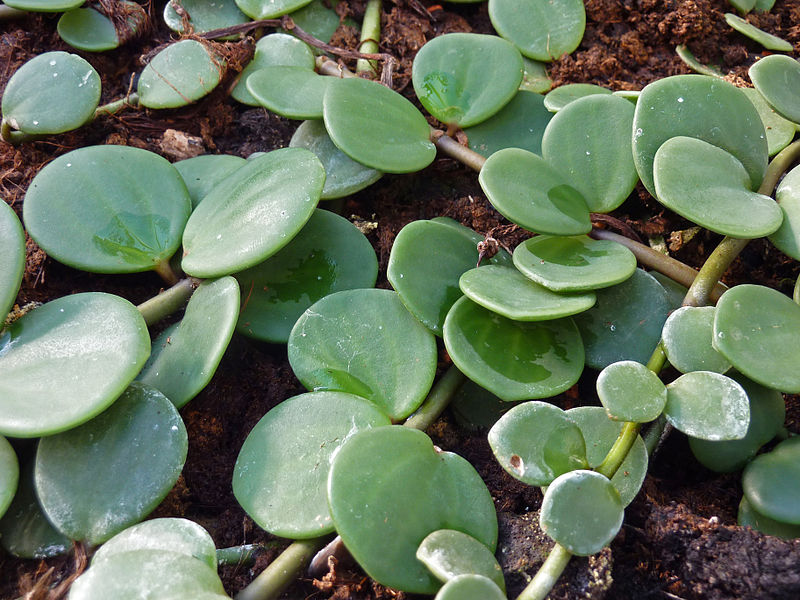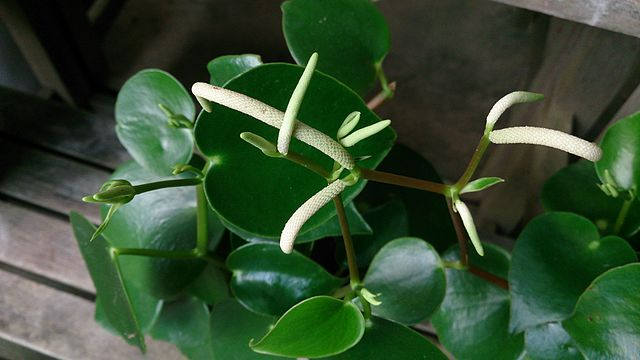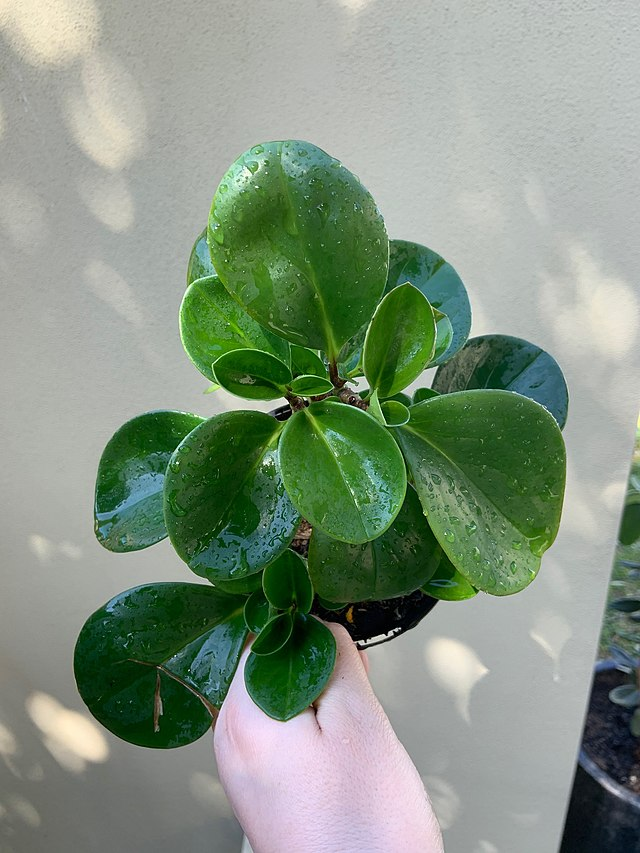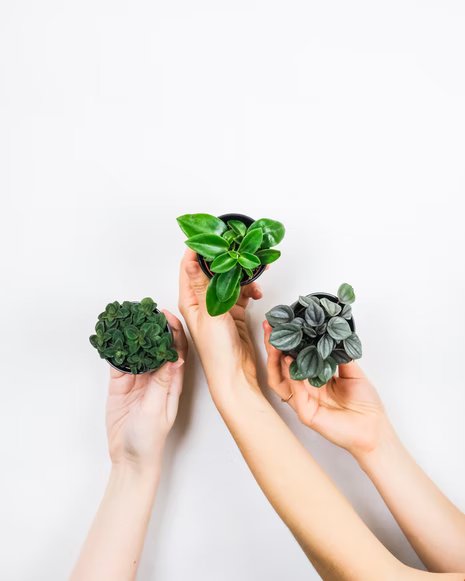Peperomia Hope is one of the most trendy houseplants nowadays, characterized by having oval leaves that are succulent-like. The leaves are small and grow mostly in clusters of up to three to four on each stem, and unlike other peperomia plants, this one grows in a trailing habit which is why it is perfect for hanging baskets or pots.
This article will tell you everything you need to know on growing and taking care of peperomia Hope inside your homes. You’ll also find tips that will help you make use of this plant’s aesthetic potential!

Peperomia Hope Profile
General Information
Peperomia Hope is a mix hybrid of two species of Peperomia, namely P. deppeana and P. quadrifolia. They are tropical plants that belong to the Piperaceae family of plants, so scientifically speaking, they hail from the same family as peppers.
They are also known to be a perennial and an epiphyte, meaning they have can absorb nutrients and moisture from the water and air through their aerial roots. Although not a succulent, its fleshy leaves store moisture similar to many types of succulents.
Peperomia is usually found in the tropical regions of Central and South America. Therefore, you already have an idea that its ideal conditions include warm and humid environments with a not so harsh light and breathable soil.
Etymology
The Peperomia Hope are also called the acorn peperomia and four-leaved peperomia. Four-leaved due to its scientific identity, Peperomia tetraphylla, which literally translates to four leaves, and acorn peperomia due to its leaf shape and venation.
Flowering

Peperomia Hope isn’t really known for its flowers, for they rarely bloom indoors. However, it can dorm small flowers on lengthy spikes that develop at the end of the stems if they do.
Season of Interest and Purchasing
If you are in a place with a cooler climate, you might want to purchase Peperomia hope during the spring or summer or the plant’s growing season.
Growth
The peperomia hope being an epiphyte are excellent houseplants that require minimal care. Add the fact that it has a trailing growth; it adds additional flair to your home’s interior. It is essential to take note as well that they grow slowly, but given the ideal temperature, water, soil, and food, they would be happy as a puppy.
Peperomia Hope Overview
| Scientific name | Peperomia deppeana x quadrifolia ‘Hope’ |
| Common name/s | Peperomia Hope, Four-leaved peperomia, Acorn Peperomia |
| Family | Piperaceae |
| Growth Habit | Succulent-like |
| Height and Spread | 4-6 inches in height, 8-12 inches spread |
| Classification based on life cycle | Perennial |
| Origin and Distribution | Originates from Central and South America |
| Climate Zone | Generally warmer climate |
| USDA Plant Hardiness Zone | USDA Zone 10 – 12 |
| Color | Evergreen succulent-like leaves that are trailing |
Care Tips
Light Requirement
Peperomia hope thrives best in filtered light. Hence, the optimum place for growing them would be in places with enough sunlight, such as window sills that are facing east and/or west. They also grow satisfactorily in rooms that are south-facing. However, you will need protection from the scorching noon sun.
Too much direct light, artificial or natural, can cause its leaves to get burnt and turn yellow. To avoid this, you can place them behind a light and sheer fabric or curtain.
Conversely, Peperomia Hope may not also grow if it remains in the shade too much. They may become leggy with sparse foliage and grow even slower. Although they can survive shady and dark conditions, it is best to give them some filtered light. If a location with more natural light is not possible, you may boost its growth and development using artificial lighting.
Temperature Requirement
Peperomia Hope thrives in average room temperatures. Ideally, they need to be kept in warm climates or temperatures ranging from 64 to 78 degrees Fahrenheit. When growing them, make sure to avoid temperature extremes. For example, avoid placing them next to a hot radiator during the winter season.
The absolute minimum temperature for peperomias is 50 degrees Fahrenheit. Also, keep them away from cold drafts and air conditioning airflow in the summer.
Water Requirement
Peperomia Hope plants are relatively drought-tolerant. As a matter of fact, it is better to water them less rather than overwatering them, as they can last a few weeks without getting hydration, thanks to their fleshy leaves. You may need to water your peperomia hope plant once every seven days during the summers, and once every 2-3 weeks in the winter.
The best way to water these plants is to follow the very efficient method, the drench and dry technique. Before watering them, make sure to check the first 2-3 inches of the potting mix. If it is already dry, drench the soil mix, and make sure to drain the excessive water before putting it again on the dripping tray.
Avoid overwatering your peperomia plant, as this increases the growth of white molds and fungus gnats on the soil.
Humidity Requirement
This plant requires a humidity that is medium to a high level. Therefore, it is ideal to keep them in a room with a humidity above a level of 50% to ensure optimum growth. It may also be helpful to use fine mist on the leaves daily using filtered or distilled water.
Other ways in order to boost the humidity level for your houseplant include the use of humidity trays, room humidifiers, and placing your plants together.
Soil Requirement
The best soil for Peperomia hope is a fertile, well-draining soil. A houseplant potting mix with peat moss together with perlite, coarse sand, or gravel is recommended. The organic matter is light which helps retain some moisture, while the inorganic matter allows excess water to drain freely, preventing root rot.
You may also use the same type of potting mix used for succulents. To do this, mix two parts regular potting mix with one part perlite and one part horticultural sand. This makes a highly porous soil mix which is ideal for your peperomia hope.
Fertilizer Requirement
Applying fertilizer monthly during the active season will significantly benefit your Peperomia hope houseplant. The extra nutrients will help your plant grow faster while attaining a filler foliage. Make sure to utilize a balanced, fertile, and organic fertilizer that would provide the right amount of nutrients your plant needs.
Some suitable fertilizer include compost tea, sea kelp, or natural extracts from plants. If you are to use synthetic plant fertilizers, make sure to flush your soil quarterly to flush out any excess salts and minerals. This step is crucial to prevent root burns caused by fertilizers.
Space Requirement
As mentioned above, Peperomia Hope has a trailing habit, so it is ideal to be placed in hanging baskets or horizontal pots. Just make sure that the plant does not outgrow its pot.
RELATED: Maranta Lemon Lime: An Easy to Follow Care, Propagation, and Watering Guide
Growing And Planting Tips

Propagation
The best and the most efficient way to reproduce Peperomia Hope is through stem cuttings. It is relatively easy to propagate them.
- Cut a viable and healthy stem of about 3 inches long below a specific node. Ensure that the healthy stem has at least two to three leaves at the stem apex or tip.
- Place the cutting in a pot or a jar to allow the development of the roots.
- Once the roots have started to develop, place the cutting in a pot with a moist potting mix. Make sure to use the proper pot size.
- Cover the plant to retain in moisture using a plastic bag.
- Place the plant in a bright and warm room.
- Keep the pot moist by misting it once every two days. Do not make it overly damp.
- Remove the cover and repot when the stem cutting has rooted extensively. Take note of the care for peperomia as mentioned above.
Another way to propagate them is through leaf cuttings. It’s quite similar to the steps above, but you cut a viable leaf, including its petiole, instead.
Pruning
Your peperomia hope houseplant needs occasional pruning. Cutting off dead stems and leggy ones will help your plant grow a bushy and healthy foliage and grow faster. It is best to do this in the early part of spring before the active growth season starts.
You may also facilitate the growth of your peperomia trail by pruning off newly emerged leaves. This helps concentrate the growth on the stem. This is particularly useful if you want it to have long stems that are dangling on the pot.
Potting and Repotting
A few telltale signs that say your plant needs repotting include:
- Roots growing out of the pot’s drainage holes
- Compacted potting soils which take longer for water to drain
- Slower plant growth even though the conditions are optimal
- Cracks appearing in the pot
Make sure to repot your houseplants as needed to encourage healthy growth and a beautiful, full, and bushy foliage.
Peperomia Hope Lime Care
| Light | Filtered bright light |
| Temperature | Intermediate to warm, 64-78 degrees Fahrenheit |
| Water | Once a week, increased in summer, decreased in winter |
| Soil | Fertile, well-draining mix |
| Fertilization | Regular household fertilizer, once a month |
| Space | Minimal space, vertical space needed |
| Propagation | Via stem propagation |
| Blooming | Rarely blooms, enough sunlight and maturity needed |
| Pruning | Occasional pruning |
| Potting | Regular potting mix or succulent mix, use of perlite and horticultural sand |
Problems And Troubleshooting
Diseases
The immediate disease that causes peperomia hope plants to induce death is bacterial and fungal infections from root rot. To prevent these from harming your peperomia plants, make sure to avoid having them overwatered. Also, make sure to only water them if the top 2-3 inches of the potting soil is cracked and dry.
Pests
The most common pests that affect the Peperomia Hope are mealybugs. Mealybugs suck the natural juices of plants, leaving them with insufficient nutrients and water to grow. They would look like tiny white critters that usually crawl under the leaves.
Also, you can observe if there is an infection if you see a cottony substance on your plant’s stems and leaves that is wool-like.
In order to eliminate them, you can utilize neem oil, one of the commercially available natural pesticides. Mix two teaspoons of neem oil to one teaspoon of liquid dishwashing soap with a liter of water that is lukewarm. Place in a spray bottle, or any other containers, and apply over the peperomia leaves.
You may also use 70-percent isopropyl alcohol to be directly applied on the bugs and other plant pests.
Curling and Falling Leaves
Curling leaves are usually because of plant pests or, in many cases, nutrient deficiency. To avoid this, check for observable signs of pests like mealybugs and eliminate them when required. If there is a lack of nutrients, you can use a proper and high-quality fertilizer feeding to augment the watering.
For falling leaves, this is usually due to overwatering. Follow the watering tips above, and make sure to only water your plant if the potting mix is dry and cracky at the top.
Peperomia Hope Pests And Diseases
| Common Pests/Diseases | Symptoms | Treatment and Prevention |
Common diseases include crown rot, stem rot, root rot, leaf spot, fungal diseases, and Xanthomonas infection | Yellowish rimming around black or dark brown spots on leaves | Avoid overwatering. Keep soil dry. Avoid too high humidity.Proper ventilation is needed around the plant. Remove infected parts of fungal infections to avoid spreading. |
| Common pests include mealybugs, spider mites, aphids, and scales | Visible insects on the surface | Spray plant with warm, soapy water. If infestation is present, use insecticide or neem oil. Use diatomaceous earth. |
Problems With People And Animals
Toxicity
The plants in the genus Peperomia such as peperomia Hope do not contain toxins. Therefore, they are safe and are not poisonous to cats, dogs, and other pets.
Peperomia Plants Meaning And Symbolism
Peperomias are known to be an agent of luck in Brazil. After all, peperomia is derived from the Greek word ‘peperi’ meaning ‘peper’ and ‘homios’, which means resembling. Thus, Peperomia Hope literally translates to “resembling hope”. Therefore, it is the perfect gift for someone who might be currently going through a tough time and needs reassurance.
| General Meaning | Agent of luck |
| Symbolism | Resembling hope |
Landscaping And Gardening Ideas

Companion Plants
While this plant looks great by itself, it would look even more marvelous when set next to the right companion plants. Fellow tropical plants go well with this plant. Particularly, it goes well with plants from the same family, such as Peperomia obtusifolia, Peperomia Quadrangularis, Peperomia metallica, and P. argyreia. It also goes well with Philodendrons, particularly Philodendron subhastatum, a climbing plant that adds a little flair to our peperomia plants.
Landscaping Ideas
Since this baby is a relatively small houseplant, it goes well with lonely corners in your house like tiny desks, empty shelves, or window sills. It may also be hung in the kitchen, or it may be set around other tropical plants.
| What to plant with | Other peperomias, Philodendrons, and other tropical plants |
| What NOT to plant with | Basically nothing |
Conclusion
This cute plant is perfect for people with appealing spaces. Its unique habit goes well for indoor landscaping and use. With its bright green leaves, clover-like formation, and relatively low maintenance care, this would definitely keep your space and eyes happy without worrying.
Frequently Asked Questions
How do you care for a Peperomia Hope?
The Peperomia Hope is a low-maintenance plant. Little care or attention is needed for this plant to thrive. However, make sure you give your plant the right environmental conditions such as light, watering, humidity, soil, etc.
Does Peperomia need sunlight?
Yes! Like all plants, Peperomias also need sunlight to photosynthesize or produce food for their nourishment and growth. Peperomias thrive in filtered bright light. However, make sure not to put your plant in direct sun to avoid burning the fleshy leaves.
Is Peperomia Hope succulent?
Yes! Botanically speaking, Peperomia Hope is a succulent. Succulents are characterized by fleshy stems and leaves, which can be found in these plants.
Is Peperomia Hope easy to care for?
Yes! Peperomia Hope plants are low-maintenance plants that require little attention and care to thrive. They are suitable for beginners.
Can Peperomia grow in low light?
Peperomias can grow in a low-light environment. However, a healthy, normal growth should not be expected. Low light conditions tend to produce plants with leggy stems, yellowish to white leaves, and broader leaf widths. These characteristics are often seen in plants grown in darker conditions.
Do you like our Peperomia Hope guide? Make sure to check out our other articles:
30 Vibrant Types of Red Succulents for Indoor and Outdoor Gardens
Top 9 Hanging Plans For Low Light – The Winning Combination For Tropical Vibe
16 Best East Facing Windows Plants – The Stars Of Rising Sun







